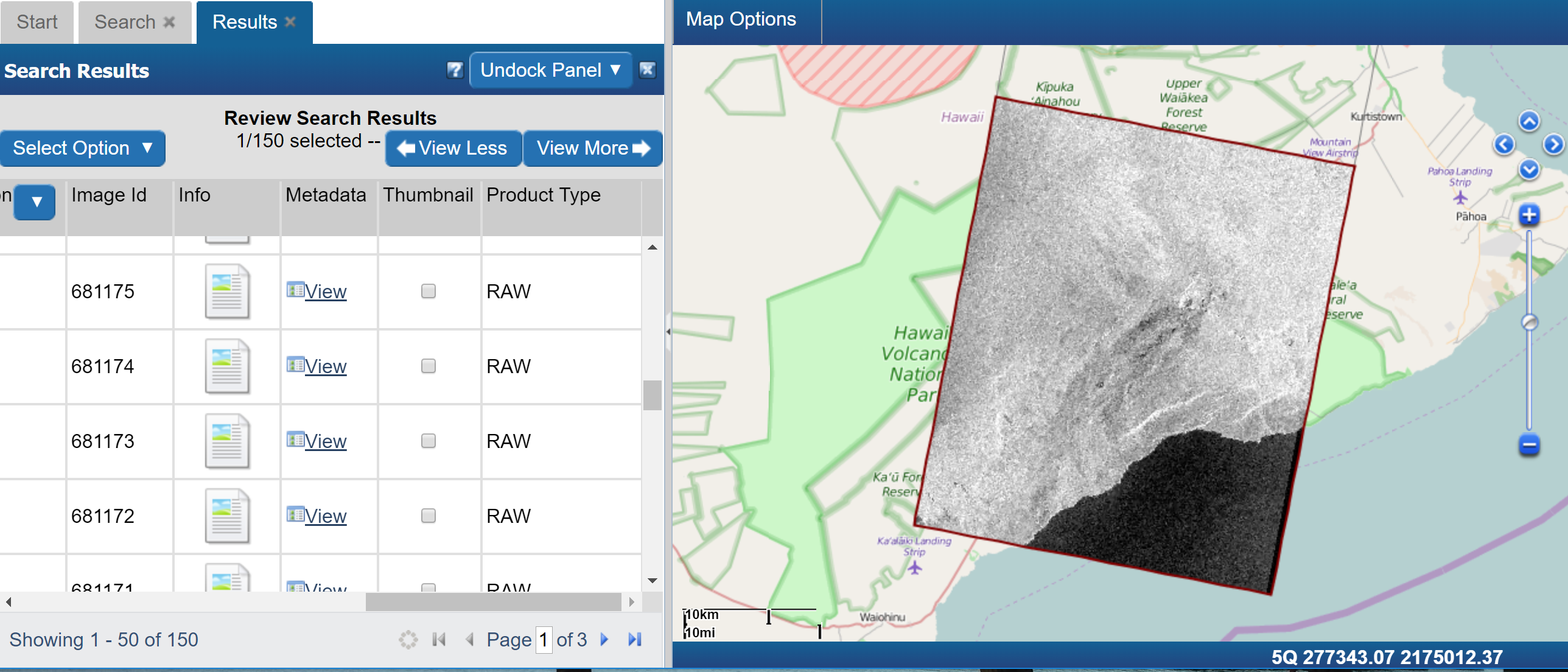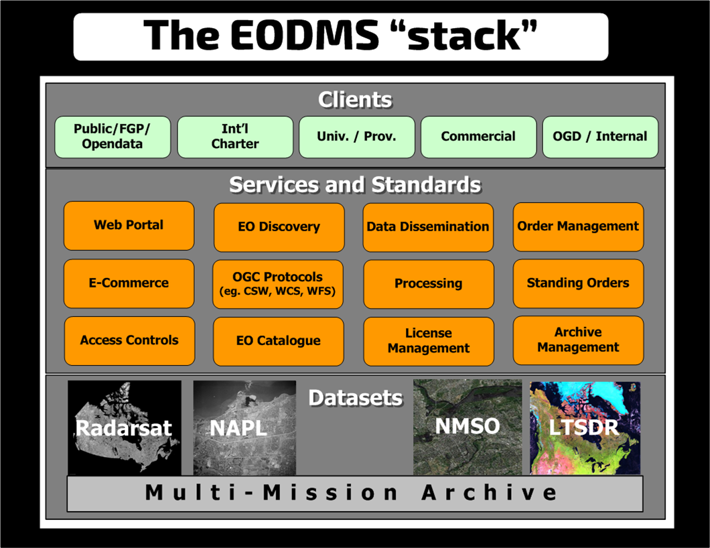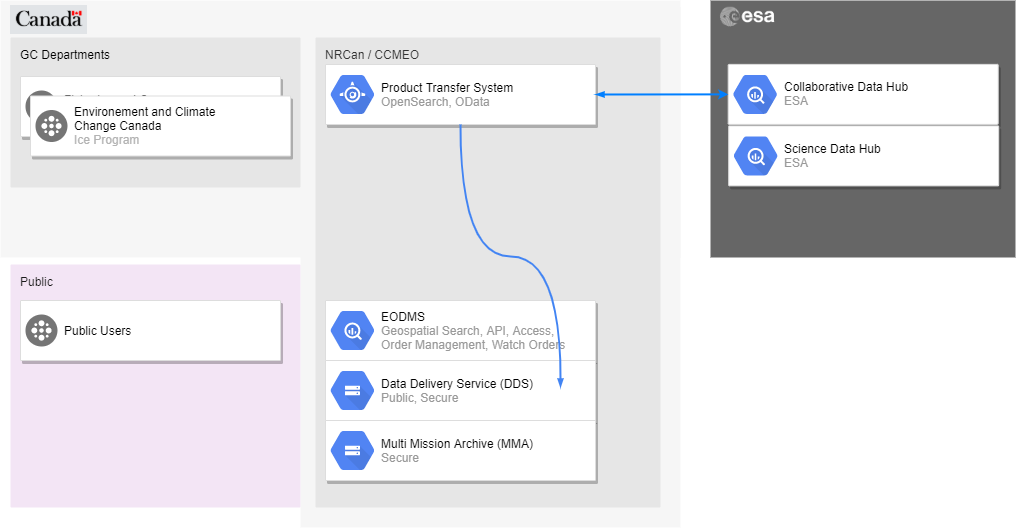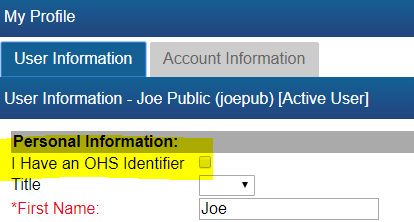Important: The GCConnex decommission will not affect GCCollab or GCWiki. Thank you and happy collaborating!
Difference between revisions of "Earth Observation Data Management System (EODMS)"
| Line 44: | Line 44: | ||
== Government/Special Access: RCM (OHS ID), RADARSAT-2, NMSO == | == Government/Special Access: RCM (OHS ID), RADARSAT-2, NMSO == | ||
| − | |||
| − | |||
| − | |||
| − | |||
| − | |||
| − | |||
=== RADARSAT-2, RADARSAT CONSTELLATION MISSION (RCM) === | === RADARSAT-2, RADARSAT CONSTELLATION MISSION (RCM) === | ||
| Line 65: | Line 59: | ||
Did you know that CSA coordinates several [[http://www.asc-csa.gc.ca/eng/funding-programs/programs/default.asp RADARSAT-2 special access programs]] to encourage the use of space data. Also available is access for the [http://www.asc-csa.gc.ca/eng/satellites/disasters.asp The International Charter: Space and Major Disasters]. Find out more [http://www.asc-csa.gc.ca/eng/funding-programs/programs/default.asp here]. | Did you know that CSA coordinates several [[http://www.asc-csa.gc.ca/eng/funding-programs/programs/default.asp RADARSAT-2 special access programs]] to encourage the use of space data. Also available is access for the [http://www.asc-csa.gc.ca/eng/satellites/disasters.asp The International Charter: Space and Major Disasters]. Find out more [http://www.asc-csa.gc.ca/eng/funding-programs/programs/default.asp here]. | ||
| − | ''EODMS | + | === NMSO-CSI === |
| + | |||
| + | The NMSO-CSI is the Government of Canada's initiative to cut down on the procurement of '''duplicate''' commercial satellite imagery across the public service. All departments with commercial satellite imagery needs should aim to route all procurement through [https://buyandsell.gc.ca/procurement-data/search/site/E60SQ-120001?solrsort=dds_publication_date%20desc NMSO E60SQ-120001] after which imagery will be loaded on to EODMS to be re-used (i.e. discovered and downloaded) by the whole of government. | ||
| + | |||
| + | All Government of Canada (GC) employees can have free access to NMSO Commercial Satellite Imagery (CSI) already purchased by the GC. Simply create an account EODMS and then send a request to your Department NMSO point of contact (PoC) for your added privileges. You can find more information on our [[EODMS_NMSO]] page as well as the request form and your PoC on our GCPedia (Government-only) page, [http://www.gcpedia.gc.ca/wiki/Earth_Observation_Data_Management_System_(EODMS)#Account_Approvals_for_Government_and_Special_Access EODMS Account Approvals for Government and Special Access] | ||
== What's New? == | == What's New? == | ||
| Line 114: | Line 112: | ||
== Accès spécial (OCPN, RADARSAT) == | == Accès spécial (OCPN, RADARSAT) == | ||
| − | |||
| − | |||
| − | |||
| − | |||
| − | |||
=== RADARSAT-2 et MCR === | === RADARSAT-2 et MCR === | ||
| Line 134: | Line 127: | ||
Saviez-vous que la CSA coordonne plusieurs [http://www.asc-csa.gc.ca/eng/funding-programs/programs/default.asp programmes d'accès spécial RADARSAT-2] pour encourager l'utilisation des données spatiales, y [http://www.asc-csa.gc.ca/eng/satellites/disasters.asp Charte internationale « Espace et catastrophes majeures »]. Pour en savoir plus [http://www.asc-csa.gc.ca/eng/funding-programs/programs/default.asp ici]. | Saviez-vous que la CSA coordonne plusieurs [http://www.asc-csa.gc.ca/eng/funding-programs/programs/default.asp programmes d'accès spécial RADARSAT-2] pour encourager l'utilisation des données spatiales, y [http://www.asc-csa.gc.ca/eng/satellites/disasters.asp Charte internationale « Espace et catastrophes majeures »]. Pour en savoir plus [http://www.asc-csa.gc.ca/eng/funding-programs/programs/default.asp ici]. | ||
| − | + | === OCPN === | |
| + | L’OCPU-ISC est l’initiative du gouvernement du Canada visant à réduire les achats d’imagerie satellitaire commerciale «en double» dans l’ensemble de la fonction publique. Tous les départements ayant des besoins en imagerie satellitaire commerciale devraient viser à acheminer tous leurs achats via [https://buyandsell.gc.ca/procurement-data/search/site/E60SQ-120001?solrsort=dds_publication_date%20desc N60OQ-120001], après quoi des images seront chargés sur le SGEDD pour être réutilisés (c'est-à-dire découverts et téléchargés) par l'ensemble du gouvernement. | ||
| + | |||
| + | Tous les employés du gouvernement du Canada (GC) peuvent avoir un accès gratuit aux images satellitaires commerciales (ISC) de l'OCPN déjà achetées par le GC. Créez simplement un compte SGDOT, puis envoyez une demande à votre point de contact OCPN pour votre privilège. Vous pouvez trouver plus d'informations sur notre page [[EODMS_NMSO]], ainsi que sur le formulaire de demande et votre PoC sur notre page GCPedia (réservée au gouvernement), à l'adresse http://www.gcpedia.gc.ca/wiki/Earth_Observation_Data_Management_System_(EODMS)#Account_Approvals_for_Government_and_Special_Access Approbation de compte EODMS pour le gouvernement et l'accès spécial] | ||
== Quoi de neuf? == | == Quoi de neuf? == | ||
Revision as of 17:05, 21 December 2019
What is EODMS?[edit | edit source]
The Earth Observation Data Management System (EODMS) is a fully integrated geospatial platform provided by NRCan/RNCan to the general public to discover and access authoritative Earth Observation (EO) data. _. Check out the EODMS How-To Guide as well.
The site is located at https://www.eodms-sgdot.nrcan-rncan.gc.ca/index_en.jsp
History[edit | edit source]
With the second largest landmass on earth and the longest coastline in the world, Canada relies on satellite technology to monitor its land and borders. Providing access to this technology is a core mandate of NRCan's Canada Centre for Mapping and Earth Observation (CCMEO). Through partnerships with government stakeholders, strong links to academia and the private sector, including international collaborations, CCMEO ensures that satellite data is available to serve the needs of the Canadian Government and all Canadians. Since 1971, CCMEO has accumulated an archive in excess of 1 PB of Earth Observation (EO) data. This data originated from various satellites and airborne sensors. The 2012 Canadian Federal Budget included NRCan’s revitalization plan which sought to maintain and improve Canada’s EO satellite capacity and access to this data. This plan was realised through the purchase and installation of four (4) new antennas as well as the brand new Earth Observation Data Management System which replaced several legacy systems.
Services[edit | edit source]
Today, CCMEO delivers several EO data services in support of the Government of Canada’s priorities on the economic development of natural resources, the North, safety, security, sovereignty, and environmental monitoring.
EODMS[edit | edit source]
Data services delivered by EODMS include:
- The user-access-controlled (i.e. Government of Canada only) discovery and ordering of RADARSAT 2 (R2) and RADARSAT Constellation Mission (RCM) product as well as commercial satellite imagery (CSI) procured through the NMSO (i.e. COSMOS-Skymed, Deimos-2, DMC, EROS-B, Flock1-ISS, Flock1-SSO, GeoEye-1, GF-1, GHGSat-D, IKONOS, IRS1C-LISS3, IRS1C-PAN, IRS1C-WiFS, IRS1D-LISS3, IRS1D-PAN, IRS1D-WiFS, IRSP6-AWiFS, IRSP6-LISS3, IRSP6-LISS4, KOMPSAT-2, KOMPSAT-3, KOMPSAT-5, PLEIADES, QuickBird-2, RapidEye, SPOT-4, SPOT-5, SPOT-6, SPOT-7, TanDEM-X, Terra, Terra/Aqua, TerraSAR-X, WorldView-1, WorldView-2, WorldView-3, WorldView-4, ZY-3).
- The generic public discovery of RAW RADARSAT-1, RADARSAT-2 , and RCM Science Data.
- The general public discovery and download of RADARSAT-1 Open Data Products
- The general public discovery and download of Canada Centre for Remote Sensing (CCRS) Thematic Data Sets,
- The general public discovery and ordering of the National Air Photo Library
- EODMS is also fully OGC compliant having implemented several standards such as Web Map Tile Service (WMTS), Web Coverage Service (WCS), Catalog Services for the Web (CSW) to name a few. EODMS also implements several geospatial ISO standards including ISO 19115 and ISO 19139.
MULTI-MISSION ARCHIVE (MMA)[edit | edit source]
The storage backbone of EODMS is CCMEO’s Multi-Mission Archive (MMA) which is the Canadian authorised repository of over 1PB of RADARSAT-1, RADARSAT-2, RCM, NAPL and NMSO commercial imagery. The capacity of the archive is currently 4 PB and growing. The data is stored robustly using redundant storage and securely to comply with RSSSA laws on access controls and dissemination.
COPERNICUS CANADIAN RELAY[edit | edit source]
To address the Near-Real-Time (NRT) requirements of its users, CCMEO retrieves data from the Copernicus Collaborative Hub and provides a Canadian FTP relay with better download speeds for Canadian end users.
CCMEO provides this service using a small Product Transfer System (PTS) to pull SENTINEL products from the Collaborative hubs via the high speed CANARIE research network through to the EU. It then stages the data on the EODMS Download Server with dependable download speeds.
While this limited access has operationalized the use of SENTINEL data to key GC programs, broad use of SENTINEL-1,2,3,5p is being considered. Please contact us for more info: mailto:nrcan.eodms-sgdot.rncan@canada.ca
Government/Special Access: RCM (OHS ID), RADARSAT-2, NMSO[edit | edit source]
RADARSAT-2, RADARSAT CONSTELLATION MISSION (RCM)[edit | edit source]
For free GC/vetted access to RADARSAT-2 / RCM:
- Create an EODMS account
- For RCM, check the "I have an OHS Identifier" checkbox in your profile.
- Provide you username to the Canadian Space Agency and indicate RADARSAT-2 or RCM in your request (ASC.r-sat.CSA@Canada.ca).
CSA Special Access Programs[edit | edit source]
Did you know that CSA coordinates several [RADARSAT-2 special access programs] to encourage the use of space data. Also available is access for the The International Charter: Space and Major Disasters. Find out more here.
NMSO-CSI[edit | edit source]
The NMSO-CSI is the Government of Canada's initiative to cut down on the procurement of duplicate commercial satellite imagery across the public service. All departments with commercial satellite imagery needs should aim to route all procurement through NMSO E60SQ-120001 after which imagery will be loaded on to EODMS to be re-used (i.e. discovered and downloaded) by the whole of government.
All Government of Canada (GC) employees can have free access to NMSO Commercial Satellite Imagery (CSI) already purchased by the GC. Simply create an account EODMS and then send a request to your Department NMSO point of contact (PoC) for your added privileges. You can find more information on our EODMS_NMSO page as well as the request form and your PoC on our GCPedia (Government-only) page, EODMS Account Approvals for Government and Special Access
What's New?[edit | edit source]
The upgrade to EODMS (from NEODF) brings new support for previously undiscover-able NMSO commercial imagery including DMC Constellation, TerraSAR-X, SPOT-4 to 7, Cosmo Skymed. There is also new support for the RADARSAT-2 NITF format. Prior to this users would have to look for this data without the help of a map on the NEODF FTP directory structure.




